Senegal – Guinea Bissau Tour

Duration: 15 days
Area: Senegal, Guinea Bissau
Style: cultural tours
Comfort Level:![]()
![]()
![]()
![]()
![]()
Highlights:
An amazing journey across an astonishing variety of landscapes and experiences, the result of many years of field research. We will travel in ten different means of transportation, each chosen to optimize the different geographical and cultural environments and have fun: comfortable air-conditioned minibus, 4WD vehicles, traditional calash, donkey chariot, local bush taxi, town Taxi, ferry boat, liner ship, local boat and modern speedboats.
A comfortable expedition from north to south in a crescendo of changing landscapes: from the dunes of the southern edge of Sahara to the Ferlo Desert in Senegal, from the “Sacred Forest” in Casamance to the longest line of mangrove swamps in Africa and on to the unknown Bijagos Archipelago. Moving across these varied ecosystems, we encounter the main natural and cultural “milieu” of West Africa.
For travellers who want to get acquainted with this intense region, like variety ... and love Africa!
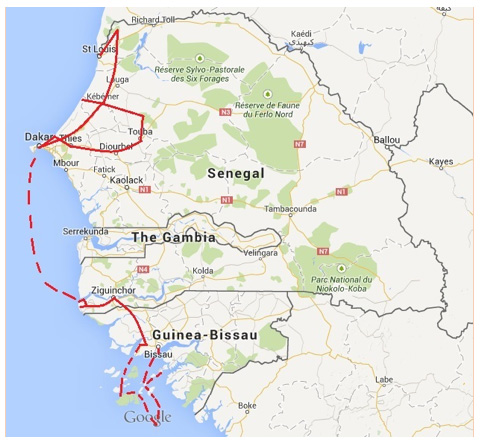
CULTURE
In the north, we will meet with the largest religious brotherhood that practices an African form of Islam that rejects fundamentalism. A special attention will be dedicated to contemporary art in Dakar, meeting the vibrant community of artists. In the south, we will be introduced to animistic traditional religions, tribal kings, dancing masks and remote tribes who still worshiping ancestor statues, a unique chance to enjoy tribal art in is original contest, the village. In the animistic Casamance region we will witness at the celebrations of two tribal masks: Mandingo mask dances representing a powerful and fired spirit that protects the initiates; Diola mask is the incarnation of mythical spirits… Masquerade is a unique experience that involves the participation of the entire village in an intense mixt of magic, music, and dances. All departures.
Depending on the departure date, we may discover these unique cultural events.
-
Vaca Bruto mask dance. In Bijagos Archipelago life is still ruled by the “cycle of seasons”. During the long dry season, when harvest is over, the main ceremonies take place. The most spectacular Bijago mask is called Vaca Bruto (wild bull) and is a wooden helmet with eyes of frosted glass, real horns, leather ears and a rope through the nostril. During the Vaca Bruto Festival dancers embody the spirit of the mask with great realism: they bow and face the ground, just like a real untamed animal would do. The mask represents a man in full possession of his physical strength but with still an immature behavior since he has not yet undergone the final initiations. All the villagers attend this fascinating ceremony.
“Vaca Bruto” mask dances - departures of: Mar. 17th, Apr. 21st
-
Carnival is the main festivity in Guinea Bissau. While tribal carnival in inland savannah villages displays tribal masks, and initiates of the region, in Bissau the capital, the great final carnival is a mix of African and Portuguese traditions. Carnival goes wild in the afternoon when along the Main Avenue, groups from all the country start many hours of a longue and intense parade: sacred traditional masks, warriors dressed in a crocodile skin and armed with arrows, initiated girls wearing only strings of glass beds around their waist and contemporary masks made of papier-mâché. Hours and hours of lively parades turn this carnival into an unforgettable experience, an intense “fiesta popular” combining Portuguese influence with the cheerful African spirit.
Carnival - departures of: Jan 31st
HISTORY
We will meet:
- Historical” sites such as Saint Louis – the first capital of the former Afrique Occidentale Francaise -, Goré former slave-trade island, and Bolama - an ancient Portuguese capital in the forest.
- Dakar, contemporary metropolis and intellectual melting pot of Indipendent Africa. All departures
- “Timeless” people as Nomadic herders, and remote villages of Casamace and Guinea Bissau.
NATURE
Following the “uncertain border” between land and water we move across spectacular variety of natural environments such as desert, savanna, forests, estuaries, mangrove swamps, ocean and islands (23% of Guinea Bissau territory is submerged at each tide). By traveling from north to south we follow the route of migratory birds, a constant presence along the whole journey. All departures
Depending on the departure date, we may discover rare endemic fauna.
Orango Island in Bijagos Archipelago is a National Park and among the many protected species there is a unique mammal: the spectacular “saltwater hippo”. These rare animals mainly live in the mangrove but sometimes even like to go for a swim in the ocean! As they move around the island in search of saltwater ponds.
Poilao in Bijagos Archipelago is uninhabited island and the main nesting site for Green Sea Turtle (Chelonia Midas) in West Africa. After dark, in silence on the beach, we await for the magic moment when a female emerges from the ocean to dig a deep hole in the sand and lay hundred or more eggs. With a bit of luck we will be able to witness the hatching! … Tiny turtles emerge from the sand to join the ocean and start a long journey that will bring them back to this same island 30 years after, when they will reach sexual maturity.
Saltwater hippos & Turtle nesting - departures of: Nov. 3rd and Dec. 29th
| Day 1 | Arrival in Dakar (Senegal) and transfer to the hotel. |
| Day 2 | Visit Dakar and the edge of the Sahara - Senegal |
| Day 3 | Drive to Saint Louis - Senegal |
| Day 4 | Bird sanctuary & Nomadic tribes - Senegal |
| Day 5 | Visit Tuba Brotherhood - Senegal |
| Day 6 | Contemporary art - Senegal |
| Day 7 | Goré Island: history and charm (drive in town) - Senegal |
| Day 8 | Forest sailing - Senegal |
| Day 9 | Sacred kings - Senegal |
| Day 10 | Cult for the ancestors - Senegal & Guinea Bissau |
| Day 11 | The Bijagos Archipelago - Guinea Bissau |
| Day 12 | The Queens island - Guinea Bissau |
| Day 13 | Canhabaque Island & Rubane Island - Guinea Bissau |
| Day 14 | Islander life - Guinea Bissau |
| Day 15 | From the ghost capital to Bissau - Guinea Bissau |
Detailed Itinerary
Day 1: Dakar, the capital - Senegal
Arrival in Dakar (Senegal) and transfer to the hotel. Free time to relax.
Meals: Free
Overnight: Hotel Djoloff, hotel de charme with fine traditional architecture and comfort, or similar (Air conditioned, en-suite rooms)
Day 2: Dakar and the edge of the Sahara (170 km – 3 hrs) - Senegal
Dakar became the center of political, artistic and intellectual “renouveau” from independence time. Visit of the “Plateau” district, the Governor Palace and some interesting markets. After lunch, by minibus we drive to the Lampoul Desert, where, at the limits of the dunes, 4WD vehicles will be waiting to take us at our camp.
Meals: included in a restaurant and at the camp
Overnight: Permanent tented camp (comfortable tents with beds and en suite)
Day 3: Saint Louis (150 km – 2 hrs) - Senegal
Drive to Saint Louis, a charming old town which was the first capital of West Africa French colonies. Having been the former base of the “Aeropostale” airmail pioneer operation between Europe, Africa and South America, Saint Exupéry himself - the famous writer and aviator, author of “The Little Prince” - had a base here as well! The best way to visit the narrow lanes of Saint Louis is by calash, just as locals do! Time to stroll in the tiny avenue and enjoy the unique atmosphere of this old town.
We will spend the night at the historic hotel of the town - built in 1895 and now fully renovated - it was here that all Aeropostale pilots use to stay.
Meals: Lunch in a typical restaurant, dinner a charming restaurant facing Senegal river.
Overnight: Hotel de la Poste or similar (Air conditioned, en-suite rooms).
Day 4: Bird sanctuary & Nomadic tribes (250 km – 5 hrs) - Senegal
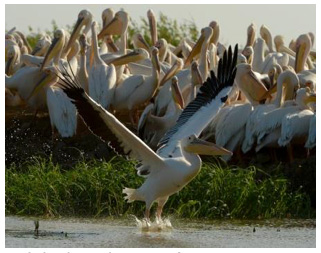 Early in the morning departure northwards to discover Djoudj National Bird Sanctuary (Parc National des Oiseaux du Djoudj), a natural oasis formed by hundreds of miles of partially flooded lands which has been declared a UNESCO World Heritage Site. This “humid paradise” - the best habitat and nesting site for over a million of migratory and resident birds - lies on the southeastern bank of the Senegal River and offers a range of wetland habitats that are very popular with migrating birds, many of which get here after crossing the Sahara. Out of over 400 species, pelicans and flamingos are the most common, whereas aquatic warblers are a bit less conspicuous - migrating here from Europe, this park is their single most important wintering site yet discovered. Apart from birds there is also a wide range of wildlife which could be encountered.
Early in the morning departure northwards to discover Djoudj National Bird Sanctuary (Parc National des Oiseaux du Djoudj), a natural oasis formed by hundreds of miles of partially flooded lands which has been declared a UNESCO World Heritage Site. This “humid paradise” - the best habitat and nesting site for over a million of migratory and resident birds - lies on the southeastern bank of the Senegal River and offers a range of wetland habitats that are very popular with migrating birds, many of which get here after crossing the Sahara. Out of over 400 species, pelicans and flamingos are the most common, whereas aquatic warblers are a bit less conspicuous - migrating here from Europe, this park is their single most important wintering site yet discovered. Apart from birds there is also a wide range of wildlife which could be encountered.
In the afternoon continuation to the Ferlo Desert to discover the arid region where nomadic Fulani tribes herds large droves of zebu. The Fulani (also called Peul) are the largest tribe roaming West African savannahs, living in a vast area from Senegal to Chad. Their origins are still covered with mystery but they all share a common and aristocratic cult for beauty and elegance. In the afternoon a local guide will join us for a visit to the neighboring villages and shelters. When the herds come back, we might even be invited to witness the milking process.
Meals: included in a local restaurant and at the camp restaurant.
Overnight: Camp made up of simple grass huts, managed by a local entrepreneur (all rooms with beds, mosquito nets are en-suite).
Day 5: Tuba Brotherhood (140 km – 3 hrs) - Senegal
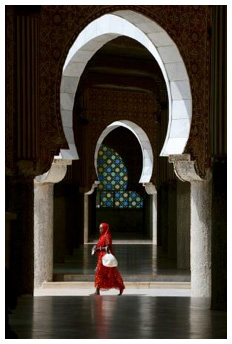 The rarely visited the holly town of Tuba (Touba) is the right place to appreciate the hospitality of an African brotherhood. Tuba inhabitants follow Mouridism and the town itself is a sort of theocratic “state within the state”, ruled by a Caliph. The founder of Mouridi brotherhood was a Sufi named Amhadou Bàmba Mbake and still today the Mouridi have a large social and economical impact in Senegal: thanks to their peaceful (and African) vision of Islam, Mouridism has become the bastion that protects Senegal from radical Islam. During the annual festival the town is visited by four million pilgrims. Mouridi welcome any interest for their traditions yet since Tuba is a sacred town, all visitors should show respect for traditional rules, therefore we must apply a considerate dress code, not smoke, not drink alcohol and not listen to music during the visit. If you follow these simple rules, you will be very welcomed. Baye Fall, a member of a colorful branch of Mouridism, will accompany us during the visit.
The rarely visited the holly town of Tuba (Touba) is the right place to appreciate the hospitality of an African brotherhood. Tuba inhabitants follow Mouridism and the town itself is a sort of theocratic “state within the state”, ruled by a Caliph. The founder of Mouridi brotherhood was a Sufi named Amhadou Bàmba Mbake and still today the Mouridi have a large social and economical impact in Senegal: thanks to their peaceful (and African) vision of Islam, Mouridism has become the bastion that protects Senegal from radical Islam. During the annual festival the town is visited by four million pilgrims. Mouridi welcome any interest for their traditions yet since Tuba is a sacred town, all visitors should show respect for traditional rules, therefore we must apply a considerate dress code, not smoke, not drink alcohol and not listen to music during the visit. If you follow these simple rules, you will be very welcomed. Baye Fall, a member of a colorful branch of Mouridism, will accompany us during the visit.
Continuation to Lac Rose, a shallow saltwater lake surrounded by dunes, also known as Lac Retba. The water is ten times saltier than in the ocean and because of the high concentration of minerals the lake often shimmers into pink. More than 600 workers here collect salt in the traditional way, visit of the salt collectors. For the more adventurous possibility to go for a “swim”, or rather a float, in the lake waters.
Meals: included in a local restaurant and at the hotel.
Overnight: Hotel Le Traza, hotel with an open-air restaurant overlooking the lake, or similar (Air conditioned, en-suite rooms).
Day 6: Contemporary art (100 km – 2 hrs) - Senegal
Morning: spectacular 4WD excursion, driving on the beach, between waves and sand for miles to discover the largest fisherman village in Senegal, more than 4500 wooden pirogues came to the shore with the catch of the day… We will live our vehicles for a less intrusive, but fun, donkey chariot to approach the fisherman selling to the local market women, to meet the artisans craving the large pirogues, the painters decorating them with bright colors and the “local saint” for final magical blessing before sailing.
We will rent a fun and colorful local taxi to joint Dakar, arrival in town to visit the “Village des Arts” composed by fifty-two artist studios (ateliers). All disciplines of the visual arts are represented (painting, sculpture, ceramics, photography, video, installation, etc.). The Village has a large gallery, which receives exhibitions year round. The Village is “the place” to meet the best artist and young talents of the Senegalese vibrant artistic scene.
Arrival at the port of Dakar to board a ferry and spend a night in Gore Island.
Meals: included in excellent restaurants.
Overnight: Hotel Municipal, “hotel de charme” in a full restored stone building, or similar (air conditioned, en-suite rooms).
Day 7: Goré Island: history and charm (drive in town) - Senegal
 Waking up in Goré before the crowd arrives is a pleasure, as strolling in the tiny stone paved alleys of this historical settlement. In Goré slaves used to be crammed and then shipped to the Americas. The town is totally restored to bear witness of those ancient times, however thanks to the nice breeze, the many restaurants and shops; Goré today has become a very pleasant and trendy location.
Waking up in Goré before the crowd arrives is a pleasure, as strolling in the tiny stone paved alleys of this historical settlement. In Goré slaves used to be crammed and then shipped to the Americas. The town is totally restored to bear witness of those ancient times, however thanks to the nice breeze, the many restaurants and shops; Goré today has become a very pleasant and trendy location.
Ferry to Dakar, and town taxi to the city centre. The best way to discover the town centre is walking through his wide avenues, impressive colonial buildings and colourful markets animated by a lively crowd.
Evening boarding the liner “Aline Sitoe Diatta” ship that links, in one night, the capital of Senegal to Casamace, the southerner region of the country.
Meals: included in a typical restaurant and on the liner ship
Overnight: Aboard the ship (air conditioned, en-suite cabins); each cabin accommodates 2 or 4 passengers)
Day 8: Forest sailing (30 km – 1 hr) - Senegal
In the early morning light, our ship enters the estuary of the majestic Casamance River … fishermen in their pirogues collecting their nets and dolphins following the vessel. From the edge of the river, we will discover the Casamance region: its large and luxuriant trees and its “sacred forests” where animistic cults are still practiced today. The one of the mains feature of this tour is the progressive and continuous change of landscapes, climates, natural environments and cultures.
We leave our ship at Carabane Island - where its historic ruins have been covered by lush vegetation – and to board a local boat which takes us to a small island where we take part in the “Essipati” dances of the women of the Diola ethnic group. Lunch in a tiny restaurant specialized in goat cheese and grilled oysters. Continuation through a labyrinth of water and mangroves.
Upon arrival on the mainland, a minibus will take us to Ziguinchor.
Meals: included in a local restaurant or pic nic and at the hotel.
Overnight: Kadiandoumange Hotel on the banks of the river or similar (air conditioned en suite rooms)
Day 9: Sacred kings (80 km – 2 hrs) - Senegal
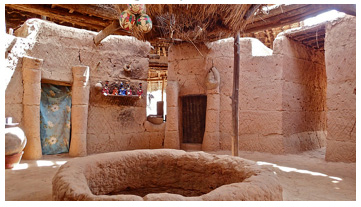 Today we visit an adobe-fortified building still inhabited by a large patriarchal Diola family, a very interesting example of traditional African “sculptural architecture”. These large clay and wooden fortified houses, where light comes from a central hole in the roof, are known as “impluvium houses” - an African variant of the ancient roman house – and had the function to protect its dwellers from outside attacks. During our visit we will be received also by the king of a Diola Kingdom. The king is also the high priest, holding both political and mystical power.
Today we visit an adobe-fortified building still inhabited by a large patriarchal Diola family, a very interesting example of traditional African “sculptural architecture”. These large clay and wooden fortified houses, where light comes from a central hole in the roof, are known as “impluvium houses” - an African variant of the ancient roman house – and had the function to protect its dwellers from outside attacks. During our visit we will be received also by the king of a Diola Kingdom. The king is also the high priest, holding both political and mystical power.
In the afternoon we follow an isolated path to a tiny village and … masks leave the sacred forest (where only initiated are admitted) to dance for an enthusiastic local crowd. Mask are part of the animistic Diola culture and Malinka traditions - people fear and respect masks, consider them spirits who play an important role in solving conflicts between villagers. Evening return to Ziguinchor.
Meals: included in a local restaurant or pic nic and at the hotel.
Overnight: Kadiandoumange Hotel on the banks of the river or similar (air conditioned en suite rooms)
Day 10: Cult for the ancestors (170 km – 3 hrs) - Senegal & Guinea Bissau
After crossing the border with Guinea Bissau we explore the region inhabited by the Manjaco. This ethnic group calls their traditions “Gendiman” and keeps them still alive and practiced. We visit tiny villages hidden in the forest to discover sculptured wooden poles called “Pecab” and representing the spirits of their ancestors, they are kept in a sanctuary known as “Cab Balugun”. With the permission of the villagers, we have the opportunity to admire sacred wooden sculptures dating back to many generations and of different styles, it is indeed a rare opportunity to enjoy tribal art in its original cultural context.
Meals: included in local restaurant or pic nic and at the hotel
Overnight: Hotel Mar Azul or similar (en-suite rooms)
Day 11: The Bijagos Archipelago (4 hrs boat) - Guinea Bissau
 In the morning departure by speedboat for a five-day navigation across the Bijagos Archipelago to discover remote islands and isolated human settlements. The Bijagos Archipelago is located approximately 40 miles off-shore and, with its 88 islands (of which only 21 are permanently inhabited), is the largest archipelago in Africa. With its wild and pristine landscapes, its unique fauna and its genuine tribal culture, Bijagos is a “geographical jewel”. The colors of Orango Island will simply fascinate us: the green vegetation, the white sand beaches, the brown rocks and the blue ocean.
In the morning departure by speedboat for a five-day navigation across the Bijagos Archipelago to discover remote islands and isolated human settlements. The Bijagos Archipelago is located approximately 40 miles off-shore and, with its 88 islands (of which only 21 are permanently inhabited), is the largest archipelago in Africa. With its wild and pristine landscapes, its unique fauna and its genuine tribal culture, Bijagos is a “geographical jewel”. The colors of Orango Island will simply fascinate us: the green vegetation, the white sand beaches, the brown rocks and the blue ocean.
For the departures of: Nov. 3rd and Dec. 29th
the itinerary will be slightly modified to participate to the visit of saltwater hippos.
For the departures of: Mar. 17th, Apr. 21st
the itinerary will be slightly modified to participate to the “Vaca Bruto” mask dances.
Meals: included, pic nic and at the hotel
Overnight: Parque Hotel locate in the vegetation in front of the ocean, or similar. (Bungalows en suite, with fan).
Day 12: The Queens island (2h30 hrs boat) - Guinea Bissau
After thirty minutes’ walk we will reach the sacred village of Okinka Pampa, hosting the graves of the Queens - a really fascinating place since this population live in a semi-matriarchal society. We will be received by the Régolo (local King), that will tell us the story of the island.
In the afternoon an intense navigation trough the islands will bring us to a spectacular virgin bay surrounded by wild beaches…
For the departures of: Nov. 3rd and Dec. 29th the itinerary will be slightly modified to witness the turtles nesting.
Meals: included, at the hotel restaurant and at the camp site restaurant.
Overnight: Fix camp, tends with beds.
Day 13: Initiates (2h30 hrs boat) - Guinea Bissau
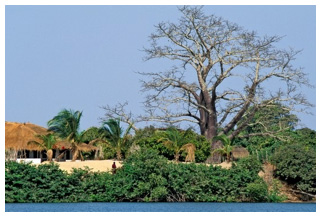 Our speedboat will reach a beach of Canhabaque Island (Ilha Roxa) where we will spend part of the day walking to villages hidden in the forest (5 hours walk on flat sandy track). Alternatively, you can visit fewer villages and relax on the beach. Canhabaque is the most traditional island of the archipelago and it is considered sacred.
Our speedboat will reach a beach of Canhabaque Island (Ilha Roxa) where we will spend part of the day walking to villages hidden in the forest (5 hours walk on flat sandy track). Alternatively, you can visit fewer villages and relax on the beach. Canhabaque is the most traditional island of the archipelago and it is considered sacred.
Due to the remoteness, the lack of transportation and the deep attachment to the local traditions, the Bijagos inhabitants have been little influenced by the external world: women still wear the saiya - a traditional skirt made of straw - and the rhythm of village life is given by initiations and secret ceremonies, as the seven-year long rite during which young men live in the “initiated house” without contact with women.
In the afternoon arrival at our base in Rubane Island where we will spend two nights. Comfortable ocean front bungalows, bar, gastronomic restaurant, swimming pool, beach.
Meals: included pic nic and at the hotel restaurant.
Overnight: Hotel Ponta Anchaca or similar (air-conditioned, en suite bungalows)
Day 14: Islander life (2 hrs boat) - Guinea Bissau
Excursion to Soga bay. Bubaque, the largest village in the archipelago and the only one connected to the continent, by an old ferry once a week. In Bubaque we will find unpaved alleys, a tiny colorful market, local bars and traders. Quite interesting the small ethnographic museum dedicated to the Bijagos culture. Return to our comfortable base at Rubane Island. In the afternoon relax at the beach or walking excursion to explore villages and luxuriant vegetation.
Meals: included, at a restaurant, at the hotel.
Overnight: Hotel Ponta Anchaca or similar (Air-conditioned bungalows en suite)
Day 15: From the ghost capital to Bissau ( 5 hrs boat) - Guinea Bissau
Early morning departure to Bolama Island, the former capital of Portuguese Guinea from 1871 to 1941, before they moved it to Bissau. When the Portuguese left, native people came to live in the town which is now falling apart and is partly invaded by tropical vegetation. The city was built following the plans of a «Castrum Romanum» (roman citadel) so today we can witness its large sunny lethargic avenues, its empty squares, its dry fountains, its bush-like gardens and its charming administrative buildings in neo Palladian style. In the Governor’s Palace we can still admire columns in the classic style and … surrounded by peaceful goats! Bolama, although inhabited, is plunged in the fairy-tale atmosphere of a ghost town.
In the afternoon, we end our speedboat navigation by arriving in Bissau, the actual capital of the country. Here a vehicle will be waiting to take us on a brief tour of this tiny and intriguing capital.
Transfer to the airport for the return flight and assistance. End of our services.
Meals: Lunch: lunch and dinner at typical restaurant in town.
Day-use: Rooms in day-use in a comfortable hotel in the liveliest district in town (air-conditioned rooms, en suite.)
Day 1: Hotel Djoloff, Hotel de charme, |
|
Day 2: Permanent tented camp, |
|
Day 3: Hotel de la Poste or similar, |
|
Day 4: Camp made up of simple grass huts |
|
Day 5: Hotel Le Traza |
|
Day 6: Hotel Municipal, “hotel de charme”, |
|
Day 7: Aboard the ship (air conditioned, en-suite cabins), |
|
Day 8 - 9: Kadiandoumange Hotel on the banks of the river or similar, |
|
Day 10: Hotel Mar Azul or similar, |
|
Day 11: Parque Hotel locate in the vegetation in front of the ocean, or similar, |
|
Day 12: Fix camp, tends with beds, |
|
Day 13 - 14: Hotel Ponta Anchaca or similar, |




